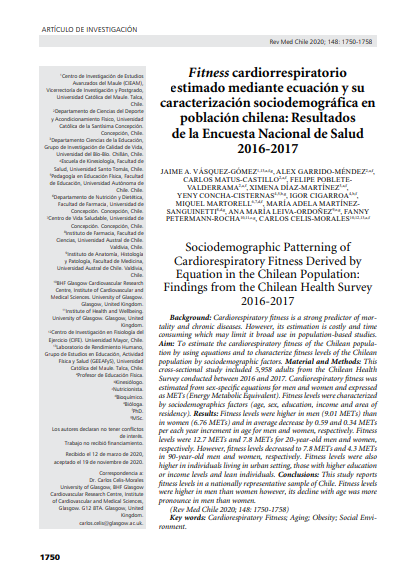Fitness cardiorrespiratorio estimado mediante ecuación y su caracterización sociodemográfica en población chilena: Resultados de la Encuesta Nacional de Salud 2016-2017

Fecha
2020-12Autor
Vásquez-Gómez, Jaime A.
Garrido-Méndez, Alex
Matus-Castillo, Carlos
Poblete-Valderrama, Felipe
Díaz-Martínez, Ximena
Concha-Cisternas, Yeny
Cigarroa, Igor
Martorell, Miquel
Martínez-Sanguinetti, María Adela
Leiva-Ordoñez, Ana María
Petermann-Rocha, Fanny
Celis-Morales, Carlos [Univ Mayor, Ctr Invest Fisiol Ejercicio CIFE, Chile]
Ubicación geográfica
Notas
HERRAMIENTAS
Acceda a títulos restringidos
¿Cómo descargar?Resumen
Background: Cardiorespiratory fitness is a strong predictor of mortality and chronic diseases. However, its estimation is costly and time consuming which may limit it broad use in population-based studies. Aim: To estimate the cardiorespiratory fitness of the Chilean population by using equations and to characterize fitness levels of the Chilean population by sociodemographic factors. Material and Methods: This cross-sectional study included 5,958 adults from the Chilean Health Survey conducted between 2016 and 2017. Cardiorespiratory fitness was estimated from sex-specific equations for men and women and expressed as METs (Energy Metabolic Equivalent). Fitness levels were characterized by sociodemographics factors (age, sex, education, income and area of residency). Results: Fitness levels were higher in men (9.01 METs) than in women (6.76 METs) and in average decrease by 0.59 and 0.34 METs per each year increment in age for men and women, respectively. Fitness levels were 12.7 METs and 7.8 METs for 20-year-old men and women, respectively. However, fitness levels decreased to 7.8 METs and 4.3 METs in 90-year-old men and women, respectively. Fitness levels were also higher in individuals living in urban setting, those with higher education or income levels and lean individuals. Conclusions: This study reports fitness levels in a nationally representative sample of Chile. Fitness levels were higher in men than women however, its decline with age was more pronounce in men than women.
URI
https://repositorio.umayor.cl/xmlui/handle/sibum/9280https://www.scielo.cl/pdf/rmc/v148n12/0717-6163-rmc-148-12-1750.pdf
http://dx.doi.org/10.4067/S0034-98872020001201750
Coleccion/es a la/s que pertenece:
Si usted es autor(a) de este documento y NO desea que su publicación tenga acceso público en este repositorio, por favor complete el formulario aquí.